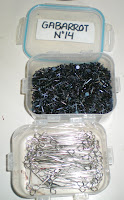The spring system was already installed in the seating area. The following photo shows the seat ready to apply the textile.







See more about upholstery on Wikipedia.
here we roll back time.
as if time had not passed.
here we roll back time and erase the memories of a piece of furniture
to start all over again.
here we roll back time, but time leaves tracks, which will not be forgotten.
here we won't roll back time but will begin to count from zero...







You probably now the Gutenberg-Project, who provides copyright-free or copyright-freed books on the Internet for free downloading.
There you can find the Illustrated History of Furniture from Frederick Litchfield (1893) (already a little bit older). I recommend to download the HTML-format because of the embedded links to the relevant illustrations.
An other recommendation concerns a book from 1909f: Mission Furniture - How to make it from Henry H. Windsor, part 1, part 2 and part 3. He describes how to make different furniture. You can find a lawn swing, a billiard table and even a nice porch chair. One of my favorites (because it's sooo retro) is the settee on page 70f.








Here you can find a link to the offical Thonet website: Thonet
Here are the basic joints for restoration (Crisi, thanks for the fotos!):
It consists of a protruding part, the tenon, and a well fitting negative form, the mortise. On the picture you see a joint cut with chisel. This technique is used e.g. on shoulder parts of chairs, but also for reparation of broken parts.
This is a Corner Bridle Joint with a 45° cut.
The Half Lap Splice has less glueing surface. This makes it a weaker joint, so we use it for smaller loads.
The Mitred Half Lap has an even smaller glueing surface.
This kind of Dovetail Joint is used for reparation of broken parts, in particular for torn seats or tables.
The Dovetail Joint prevents withdrawal.
On the following website you will find all joints with description, possible applications and methods:
http://en.wikipedia.org/wiki/Woodworking_joints
At the moment I'm working on following chairs (details coming soon):
This one has a horrible finish but some nice carvings.
Let's see if we can save the chair seat...
This is a nice chair but was upholstered at least three times, the latest with some plastic coating.
The Thonet chair is nearly done. Details will come up soon...
These are some wonderful school chairs who unfortunately were repaired with nails, and they don't go out easily.
And the last acquisition.
Hope you're interested to see what becomes of all the chairs! So keep in touch.
You can buy fish glue in pearls. You soak them in doble amount of water over night. The next day you can heat the mixture up in a water bath until the pearls are dissolved totally. It smells bad but the pearls have nearly no expiry date and the glue can be reheated whenever you want to use it again. But you have to apply it rapidly as it toughens and gets hard quickly. 
Please, feel free to add a comment if you found a good webpage explaining woodworking techniques, about history of ancient furniture, restoration in general or whatever you find interesting to be shown on this site.